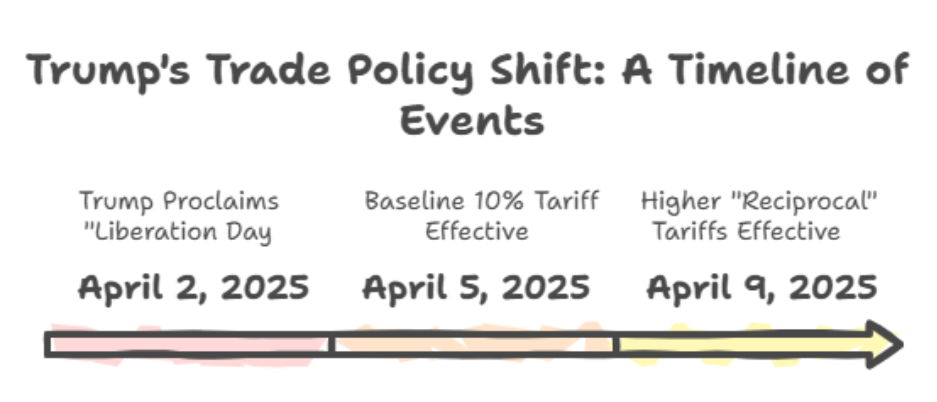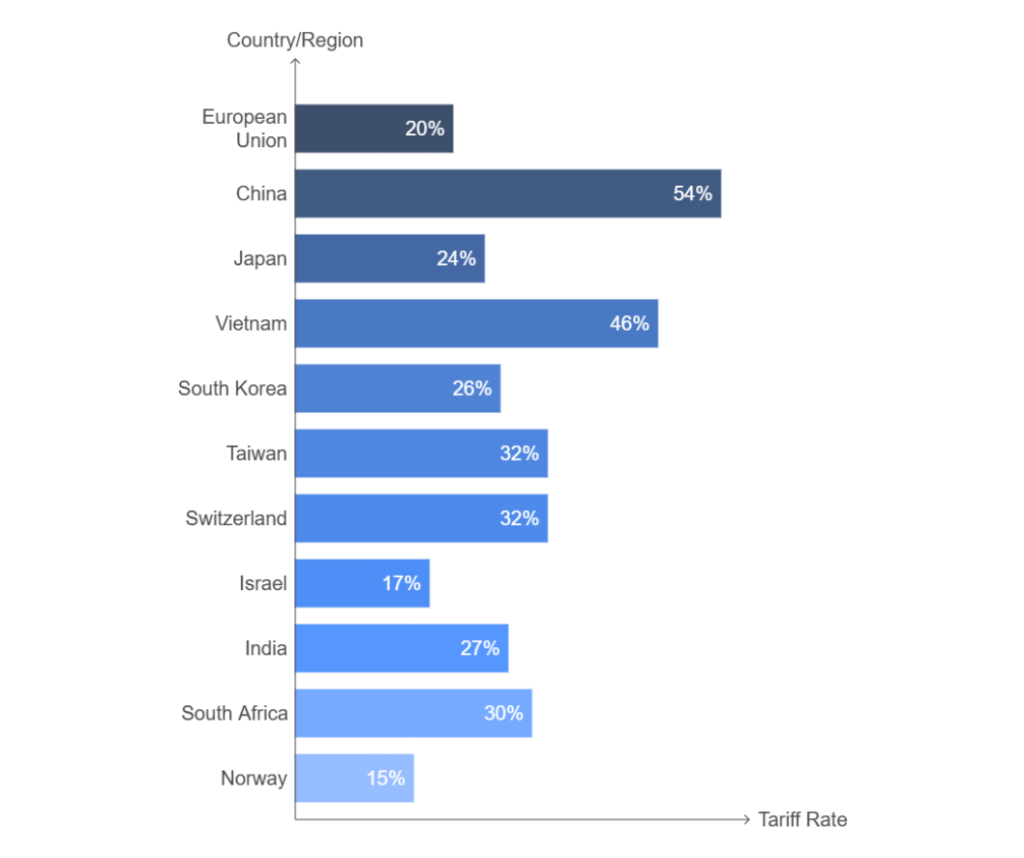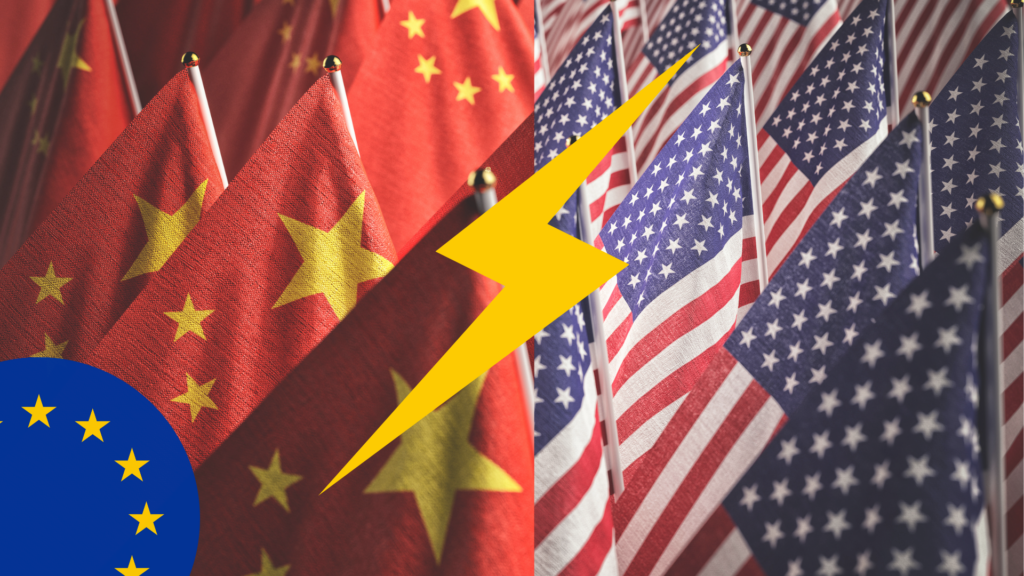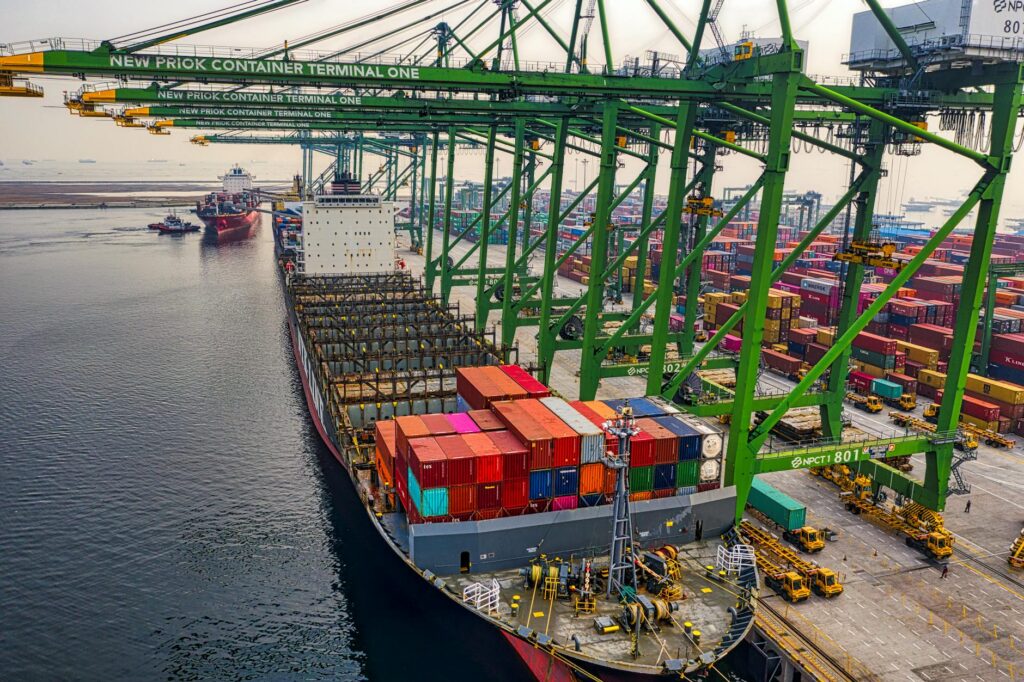Global trade war tensions have escalated sharply following President Trump’s surprise declaration of “Liberation Day” on April 2nd, 2025. In one sweeping move, the U.S. has imposed broad tariffs on nearly all imports, shaking the foundations of international trade and alarming global markets.

Table 1.0 Tariff rates time-line
With rising fears of retaliation, price hikes, and fractured supply chains, the world is watching closely. So, how did we get here—and what’s next for businesses, governments, and everyday consumers? Let’s break down the key developments and what they could mean for the future of global commerce.
Global Trade War Tariffs: Breaking Down the New U.S. Policy
When the United States announces sweeping trade measures, the world listens. On April 2nd, 2025, President Donald Trump declared “Liberation Day” — a moment he said would mark the rebirth of American industry. But what followed wasn’t just another political slogan.
It was a fundamental reordering of trade relations between the U.S. and much of the world.
If you’re navigating global trade, or your business relies on international supply chains, it’s essential that you understand exactly what’s changed — and what it might mean for you.
A Universal Starting Point: The Baseline 10% Tariff
Let’s begin with what affects nearly everyone. As of April 5th, the United States has imposed a 10% tariff on nearly all imports from all trade partners. This is the new default — what you can think of as the baseline.
You might assume this is limited to a few industries or select countries. It isn’t. From machinery to textiles, electronics to food products, nearly everything that enters the U.S. from abroad now comes with a 10% cost bump. This is the kind of sweeping move that hasn’t been seen in a century, not even during the heavy protectionist era of the 1930s. And this baseline tariff applies regardless of whether the trade partner has a surplus, deficit, or neutral balance with the U.S.
For importers, manufacturers, and international suppliers alike, the immediate result is increased cost. If your business exports to the U.S., you’re already calculating how this 10% will impact your pricing. If you import U.S. goods or rely on American machinery or raw materials, you may already be planning for price changes downstream.
A Second Layer: The “Reciprocal” Tariff Rates
Then there’s the second, more complex layer: reciprocal tariffs. Unlike the universal baseline, these are targeted and vary widely depending on the country in question. The idea, as explained by the U.S. administration, is to match or mirror the tariff rates that other nations already apply to American goods — or, in some cases, to penalize non-tariff barriers seen as unfair.
Here’s a quick overview of what’s now in place (effective April 9th):

Table 1.1 : Tariff rates by Country/Regions
As you can see, these aren’t minor adjustments. In some cases, they more than quadruple the baseline rate. If you operate in or trade with one of these countries, you’ll need to factor in a much steeper cost of entry into the U.S. market.
This tiered system introduces a new level of complexity into global trade — not just in terms of pricing but in terms of planning, compliance, and logistics. It’s not just about what your margins look like today. You’ll need to think long-term about how supply chains, distribution networks, and partnerships may evolve in response.
Strategic Exemptions: A Temporary Breather?
A few sectors have been spared, for now. Products like semiconductors, certain medical devices, pharmaceuticals, and gold are exempt from the higher reciprocal tariffs. If you’re in these industries, you may find temporary relief — but the administration has already hinted that further investigations may lead to future duties, especially on pharmaceuticals.
You may feel a sense of uncertainty here — and you’re not alone. The lack of clarity on how long these exemptions will last means that companies in these sectors still need to tread cautiously. The rules may shift again in the months ahead.
Why It Matters – And What You Should Watch
So why does all this matter? Because the changes don’t just affect direct trade with the United States. These tariffs could ripple across global markets. Countries affected by higher U.S. tariffs are already preparing retaliatory measures. Some may raise their own duties on American goods, while others might seek to strengthen ties with alternate trading partners — the EU with China, or Japan with South Korea, for instance.
If you’re involved in international commerce — whether as a manufacturer, buyer, logistics provider, or policymaker — the implications of a global trade war are no longer theoretical. You’re likely already feeling the early signs: rising costs, tense negotiations, longer lead times, and a new level of risk around forecasting.
It’s a moment where you’ll want to pay close attention to both your immediate numbers and your broader strategic plans. These tariffs don’t just represent a policy shift — they represent a signal that trade is no longer business as usual.
How the Global Trade War Is Sending Ripples Through Markets and Business

When the President of the United States calls a sudden policy change “Liberation Day,” you can expect markets to react—not with confetti, but with caution. On April 2nd, 2025, sweeping new tariffs sent a clear message: the global trade landscape has fundamentally shifted. If you’re wondering what that means for the real economy, financial markets, and businesses like yours, you’re not alone.
This wasn’t just another political headline. It was a seismic event—one that triggered immediate, visible tremors across global financial systems and industry sectors. Let’s unpack what’s happening and what you should be watching.
Markets Respond with Unease—and a Search for Safety
You might have noticed it already: global stock markets took a hit the moment the tariffs were announced. According to Reuters, U.S. stocks have already shed nearly $5 trillion in value since February. That number isn’t just symbolic—it reflects how rapidly investor confidence is deteriorating amid fears of a prolonged global trade war.
Stock futures dropped sharply in the hours following the announcement, and European markets opened lower as well (CNBC). This kind of synchronized global downturn is rare outside of crises, and it tells you something important: markets are pricing in more than a short-term disruption—they’re bracing for a fundamental realignment.
Meanwhile, safe-haven assets like gold are holding near record highs (Reuters). When that happens, it usually means institutional investors are reducing risk. For you, whether you’re managing a business or monitoring your retirement portfolio, it’s a signal that sentiment has taken a defensive turn.
The Real Economy Starts Feeling the Pressure
Beyond the headlines, you’re likely to feel the impact of the tariffs in real, practical ways—especially if you’re involved in global supply chains or reliant on imported goods. Deutsche Bank estimates these new tariffs could shave off 1 to 1.5% of U.S. GDP this year alone (DW), while others warn the economy could shrink by as much as 10% in the next quarter (CNBC). That’s not just a macroeconomic forecast—it translates into slower growth, tighter margins, and a tougher business environment for everyone.
For manufacturers, the challenges are immediate. Tariff uncertainty has already started to slow industrial activity worldwide (Reuters). If your business sources parts or raw materials from East Asia, for instance, you’re looking at significantly higher input costs—especially as tariffs on Chinese goods now stand at a staggering 54% when combined with existing duties (DW). This affects everything from electronics to textiles.
“The biggest change to global trade in 100 years,” BBC
And let’s not forget supply chains. Many businesses have spent years building lean, efficient global operations. Suddenly, they’re being forced to rethink those strategies—fast. The BBC called it “the biggest change to global trade in 100 years,” and with good reason. You’re not just looking at price hikes; you’re staring down a full recalibration of how goods move across borders.
From Boardrooms to Storefronts: Businesses Adapt Under Pressure
If you’re a business leader, this moment demands both strategic clarity and operational flexibility. The pricing environment is likely to remain volatile, and passing on costs to consumers may not always be viable. Many companies are already considering regional sourcing alternatives, hedging their currency exposure, or revisiting their product mix to manage the blow.
For example, the automotive industry—already hit with a fresh 25% tariff on foreign-made vehicles—is facing potential manufacturing slowdowns and price hikes (CNBC). Tech companies and gadget makers, too, are confronting new uncertainties, particularly around semiconductors and electronic components sourced from East and Southeast Asia.
Supply Chains in a Storm: How the Global Trade War Is Reshaping Key Industries
When you think of a global trade war, your first thought might be of politics, policy, or maybe stock markets. But for most businesses, the real disruption starts with something far more tangible—your supply chain. Whether you’re in retail, manufacturing, or technology, the ripple effects of recent tariff changes are likely hitting closer to home than you expected.
The latest wave of U.S. tariffs, announced abruptly on April 2nd, 2025, has thrown supply networks into chaos. From raw materials to finished goods, industries around the world are now facing shipping delays, rising costs, and limited availability. And if you’re feeling the pressure already, you’re not alone.
Global Trade War Fallout: What It Means for Consumers
If your business touches the consumer goods sector, you’re probably seeing prices start to creep upward—or supply timelines stretch. That’s not a coincidence. The tariffs now target a wide range of imports from East and Southeast Asia, including textiles, footwear, home electronics, and everyday household goods.
According to CNBC, new U.S. import duties of up to 25% now apply to consumer items like smartphones, televisions, and home appliances. These costs rarely stay behind the scenes—they almost always get passed down the line, either to distributors or directly to consumers. If you’re importing finished products, you’ll likely need to renegotiate contracts, revise pricing, or reassess stock strategies just to stay competitive.
Even brands with domestic assembly plants aren’t immune. Most consumer products depend on globally sourced components—microchips, plastics, fabrics, and packaging—and when tariffs inflate those costs, your margins can take a hit fast.
Manufacturing Is Facing a Raw Materials Crunch
For those of you in manufacturing—especially advanced or precision industries—the global trade war is reshaping how and where production can happen. Take metals and electronic components, for example. These aren’t easy to source locally, and most supply chains in these categories are deeply tied to Asian markets.
As DW reports, Chinese goods are now facing an effective tariff rate of 54% in the U.S. market. That affects everything from steel sheets and machinery parts to industrial chemicals and batteries. If your operations depend on a steady flow of inputs like these, you’re probably scrambling to find alternative suppliers—or paying more to keep current ones.
And it doesn’t stop at China. Suppliers in Japan, South Korea, and even the EU are being caught in the policy crossfire. A lot of U.S.-based manufacturers are discovering just how vulnerable they are to policy shifts made an ocean away. And if you’re outside the U.S., you’re probably watching your own country’s response, as counter-tariffs and new trade alliances are quickly taking shape.
Logistics and Lead Times Just Got More Complicated
It’s not only what you’re buying—it’s how and when it gets to you. The sudden wave of tariffs has triggered a spike in shipping volumes as companies rush to beat new deadlines. That’s causing bottlenecks at ports, warehouse congestion, and longer lead times across the board.
You may find yourself waiting days—or even weeks—longer for shipments that would have arrived on time just months ago. Shipping costs are also rising, especially if you’re relying on trans-Pacific routes, where container availability is tightening.
Add to that the rising cost of insurance, freight, and customs clearance, and you’re looking at a whole new logistics environment—one where agility and foresight matter more than ever.
The Countermove: How the World Is Responding to a New Global Trade War
When one of the world’s largest economies rewrites trade rules overnight, you can expect the rest of the world to take notice—and respond. The United States’ sweeping new tariffs, unveiled on April 2nd, 2025, have sparked concern, frustration, and a firm resolve among its trading partners to push back. If you’re wondering how major economies like the European Union and China might retaliate, you’re not alone.
Trade isn’t just about economics—it’s about relationships. And when those relationships are strained, it doesn’t take long for policy reactions to follow.
The European Union Signals It Won’t Sit Quietly
The European Union, historically one of the closest allies of the United States, has taken a measured yet firm stance. According to DW, EU Commission President Ursula von der Leyen called the U.S. move “a threat to the rules-based international trade system” and promised a calculated response. The EU is already finalizing a first round of countermeasures, particularly in sectors hit hardest, like steel and aluminum.
So what does that mean for you if you’re in a sector that trades with or depends on European goods? It means added scrutiny, possible tariffs on U.S. exports into Europe, and a more complex regulatory environment in the months to come.
The EU is likely to target politically sensitive goods—everything from American-made motorcycles to whiskey and even tech hardware. These decisions are rarely accidental. They’re designed to apply pressure while keeping broader diplomatic options open.
China’s Counterpunch May Be Swift and Strategic
China’s response, though still evolving, is expected to be both sharp and highly calculated. As CNBC reported, the Chinese Ministry of Commerce has already issued a strong statement calling for the immediate cancellation of the tariffs and pledging “resolute countermeasures.”
You should expect China to respond with targeted tariffs of its own—likely focusing on U.S. agricultural products, vehicles, and key manufacturing exports. These are sectors where U.S. producers are especially reliant on Chinese buyers, making them ideal for political and economic leverage.
Beyond tariffs, China could also use non-tariff tools: tightening regulatory reviews for U.S. firms, delaying approvals for American investments, or adjusting import quotas. If your business depends on smooth U.S.-China trade flows, it’s wise to monitor these developments closely and consider contingency planning.
Global Alliances May Begin to Shift
One of the less talked-about—but equally significant—outcomes of this escalating global trade war is the potential realignment of global alliances. When the U.S. enforces protectionist measures, it risks pushing its partners closer together—just not with Washington.
According to DW, Japan, South Korea, and China have already expressed intentions to strengthen their own trilateral cooperation on trade and economic issues. Canada is reportedly eyeing deeper ties with the EU, while Latin American countries like Mexico and Brazil are seeking to diversify their export markets.
If you’re engaged in international trade, now is the time to pay attention to emerging alliances. These shifts could open up new sourcing opportunities—or present new barriers if you’re reliant on the old trade order.
Retaliation Is Likely, but It’s Also Predictable
Retaliation sounds like a strong word, but in trade, it usually follows a script. When one side imposes tariffs, the other side usually does the same—often at an equivalent scale. The key for your business is to anticipate where those retaliatory measures will land.
Will it be in your product category? Will it affect key suppliers? Or will it change how your goods are routed through international markets?
Knowing the answers now helps you adapt before the full impact sets in.
The current wave of tariffs marks more than just a policy shift—it signals a pivotal moment in the unfolding global trade war. From disrupted supply chains to shaken investor confidence, the ripple effects are already being felt across industries and borders. As countries weigh their responses, the road ahead remains uncertain, with high stakes for governments, businesses, and consumers alike.
Now more than ever, staying informed and agile is crucial. What are your thoughts on these developments? Do you believe this trade war could reshape global alliances for good? We’d love to hear from you—share your insights in the comments, and don’t forget to explore our other resources on international trade and market strategies. If you found this article helpful, feel free to share it with your network and visit our website for more updates.
For expert guidance and hassle-free steel procurement, visit our website Star Trading Global and discover how we can help you optimize your sourcing strategy. If you found this post valuable, don’t forget to share it with your network!



